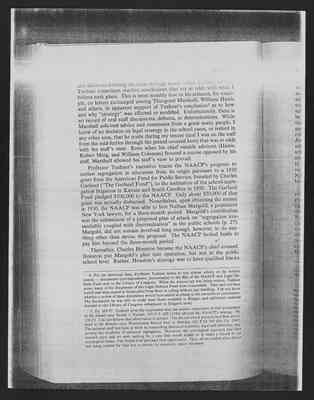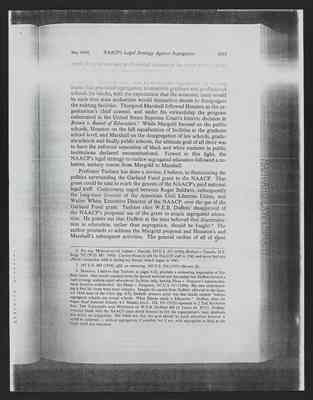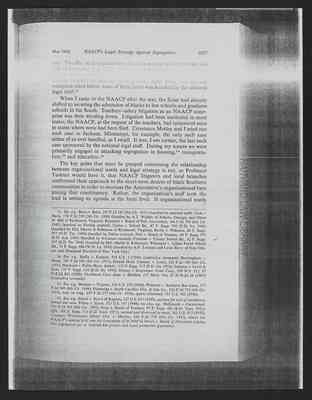Pages
1
NAACP'S LEGAL STRATEGY AGAINST SEGREGATED EDUCATION
Robert L. Carter*
THE NAACP's LEGAL STRATEGY AGAINST SEGREGATED EDUCATION, 1925-1950. By Mark Rushnet. Chapel Hill: University of North Carolina Press. 1987. Pp. ix, 222. Cloth, $29.95; paper, $9.95.
It may be doing Professor Tushnet a disservice for me to review his book since I was one of the lawyers involved in the planning and execution of the "strategy" he seeks to explore. Yet, I suppose that one in my position should be able to appraise more closely the accuracy, if not the merits, of such an examination.1
Much of the historical ground covered by Professor Tuchnet's study has been plowed rather thoroughly. Richard Kluger's Simple Justice2 and Robert Rabin's Lawyers for Social Change: Perspectives on Public Interest Law are prime examples. Since Kluger's study narrated many of the events that Tushnet covers, and Ravin used NAACP staff as a model for public interest law activity, ay author would be somewhat pressed to add much of anything new.
Professor Rushnet seems, in particular, to be constantly looking over his shoulder at Klyger's Simple Justice in an attempt to stake out a territory of his own. He states: (M)y narrative has a narrower scope than (Kluger's Simple Justice) in regard to both the period of time covered and the subject matter discussed. It is infomred by a concern for the constraints place on the litigation strategy by organizational needs, and for the significance of the NAACP campaign as it applies to the theory and practice of public interest law in general. It is, therefore, an interpretation as well as a narrative of events. (p. xi)
While I appreicate the extent to which one's present personal recollection of events long past is suspect, I am convinced that in this instance the written record does not provide a full picture of the events
[Footnotes] * Judge, United States District Court for the Soouthern District of New York. 1. I am somewhat troubled by one thing which I did not recall and do not now recall even after learning from a reference in the book that it occurred. P. 101,, n.12. Professor Tushnet interviewed me in 1980 in the course of preparing this treatise. I have no recollection of it or him, and as far as I can tell, he uses the interview only to support the written record of my firm commitment to a direct attack on school segregation. It seems evident, therefore, that the interview did not influence the writing of the book or its review. 2. R. KLUGER, SIMPLE JUSTICE (1975). 3. Rabin, Lawyers for Social Change: Perspectives on Public Interest Law, 28 STAN. L. REV. 207 (1970).
2
Michigan Law Review (Vol 86:1083
and decisions forming the legal strategy about which Tushnet writes. Tushnet sometimes reaches conclusions that are at odds with what I believe took place. This is most notably true in his reliance, for example, on letters exchanged among Thurgood Marshall, William Hastie and others, in apparent support of Tushnet's conclusion5 as to how and why "strategy" was affected or modified. Unfortunately, there is no record of oral staff discussions, debates, or determinations. While Marshall solicited advice and comments from a great many people, I know of no decision on legal strategy in the school cases, or indeed in any other area, that he made during my tenure (and I was on the staff from the mid-forties through the period covered here) that was at odds with the staff's view. Even when his chief outside advisors (Hastie, Robert Ming, and William Coleman) favored a course opposed by his staff, Marshall allowed his staff's view to prevail.
Professor Tushnet's narrative traces the NAACP's program to outlaw segregation in education from its origin pursuant to a 1930 grant from the American Fund for Public Service, founded by Chalres Garland ("The Garland Fund"), to the institution of the school-segregation litigation in Kansas and South Carolina in 1950. The Garland Fund pledged $100,000 to the NAACP. Only about $20,000 of that grant was actually disbursed. Nonetheless, upon obtaining the money in 1930, the NAACP was able to hire Nathan Margold, a prominent New York lawyer, for a three-month period. Margold's contribution was the submission of a proposed plan of attack on "segregation irremediably coupled with discrimination" in the public schools (p. 27). Margold, did not remain involved for long enough, however, to do anything other than devise the proposal. The NAACP lacked funds to pay him beyond the three-month period.
Thereafter, Charles Houston became the NAACP's chief counsel. Houston put Margold's plan into operation, but not at the public school level. Rather, Houston's strategy was to have qualified blacks
[Footnotes] 4. For his historical data, Professor Tushnet seems to rely almost wholly on the written record - documents (correspondence, memoranda) in the files of the NAACP and Legal Defense Fund now in the Libray of Congress. When the manuscript was being written, Tushnet notes, many of the documents of hte Legal Defense Fund were inacccessible. They had not been sorted and were stored in boxes piled from floor to ceiling without any labelling. I do not know whethere a review of these docments would have added anything to his narrative or conclusions. The documents he was able to study were those available to Kluger, and additional material donated to the Library of Congress subsequent to Kluger's study. 5. Pp. 105-37. Tushnet gives the impression that the sudden constraints of trial preparation in the Sweatt, case Sweatt v. Painter, 339 U.S. 629 (1950) affected the NAACP's strategy. Pp. 126-29. I do not believe that observation is correct. That all-out-attack position had been articulated in the Mendez case, Westminster School Dist. v. Mendez, 161 F.2d 749 (9th Cir. 1947). The national staff had been at work in researching historical materials, legal and otherwise, supporting the invalidity of enforced segregation. Moreover, the sociological approach had been decided upon and we were waiting for a case that would enable us to make a record of our sociological thesis. The Sweatt trial provided the opportunity. Thus, all we needed when Sweatt was being readied for trial was to secure the necessary expert witnesses.
3
May 1988) NAACP's Legal Strategy Against Segregation 1085
apply for graduate and professional training in the states where blacks were barred from existing state graduate and professional institutions [illegible line] tablished.6 Houston's aim was to undermine segregation by forcing states that practiced segregation to establish graduate and professional schools for blacks, with the expectation that the economic costs would be such that state authorities would themselves decide to desegregate the existing facilities. Thurgood Marshall followed Houston as the organization's chief counsel, and under his stewardship the program culminated in the United States Supreme Court's historic decision in Brown v. Board of Education.7 While Margold focused on the public schools, Houston on the full equalization of facilities at the graduate school level, and Marshall on the desegregation of law schools, graduate schools and finally public schools, the ultimate goal of all three was to have the enforced separation of black and white students in public institutions declared unconstitutional. Viewed in this light, the NAACP's legal strategy to outlaw segregated education followed a cohesive, unitary course from Margold to Marshall.
Professor Tushnet has done a service, I believe, in illuminating the politics surrounding the Garland Fund grant to the NAACP. That grant could be said to mark the genesis of the NAACP/s paid national legal staff. Controversy raged between Roger Baldwin, subsequently t the long-time director of the American Civil Liberties Union, and Walter White, Executive Director of the NAACP, over the use of the Garland Fund grant. Tushnet cites W.E.B. DuBois' disapproval of the NAACP's proposed use of the grant to attack segregated education. He points out that DuBois at the time bellived that discrimination in education, rather than segregation, should be fought.8 The author proceeds to address the Margold proposal and Houston's and Marshall's subsequent activities. The general outline of all of these
[Footnotes] 6. See, e.g., Missouri ex rel. Gaines v. Canada, 305 U.S. 336 (1938); Bluford v. Canada, 32 F. Supp. 707 (W.D. Mo. 1940). Charles Houston left the NAACP staff in 1940, and never had any official connection with it during my tenure, which began in 1945. 7. 347 U.S. 483 (1954), affd. on rehearing, 349 U.S. 294 (1955) (Brown II). 8. However, I believe that Tushnet, at pages 8-10, provides a misleading impression of DuBois' views. One would conclude from the quoted material and discussion that DuVois favored a legal strategy seeking equal educational facilities only, leaving Plessy v. Ferguson's separate-butequal doctrine undisturbed. See Plessy v. Ferguson, 163 U.S. 537 (1896). My own understanding is that his views were more complex. Despite the quotes from DuBois' editorial in the January 1934 issue of the Crisis (pp. 8-9), DuBois' primary point was that blacks needed "neither segregated schools nor mixed schools. What (blacks need) is Education." DuVois, Does the Negro Need Separate Schools 4 J. NEGRO EDUC. 328, 335 (1935) reprinted in 2 THE SEVENTH SON, THE THOUGHTS AND WRITINGS OF W.E.B. DUBOIS 408 (J. Lester ed. 1971). DuBois' eventual break with the NAACP came about because he felt the organization's basic emphasis was solely on integration. His belief was that the goal should be equal education however it could be achieved - without segregation, if possible, but if not, with segregation as long as the black child was educated.
4
1086 Michigan Law Review (Vol. 86:1083
events is known, the details [illegible] however less familiar and are of considerable interest.
The interpretive prong of Professor Tushnet's thesis - less successful than the narrative one - attemptsto show that the NAACP's legal strategy for desegregation was ad hoc, pragmatic, and subject to shifts and modiications influenced by organizational needs. I am not perusaded by this thesis, principally for twoeasons. The first is that Professor Tushnet couples the university and public school cases, which sought to undermine the consttutionality of seggton in educaion, with liigation that sought to secure equal pay for black teachers. He therefore treats these two independent litigation programs as if they were one. The second source of my disataction is Professor Tushnet's failure to account for or to understand the reasons that led the NAACP/s national legal staff not simply to advocate "separate but equal" facilities, but to press relentlessly for a direct attack on Pleassyv. Ferguson.9
Tushnet's emphasis on the teachers'-salary litigation and the initial failure of litigation in North Carolina and Tennessee to redress university segregation does not make his intended point.10 The teacher's - salary litigation and the university and school cass were a breed apart. The litigation to equalize the pay of black teachers was not an attack on segregation in education. Nor was it an effort to integrate teaching staffs. It simply sought to upgrade the pay scale of black teachers to that of white teachers. The only justification I can discern for lumping the school segregation and teacher-pay litigation together is that the teachers'-salary cases advance the book's thesis that the NAACP's legal strategy was subject to mutation as demanded by organizational requisites.
In the teachers'-salary litigation, the named teacher-plaintiff was exposed and vulnerable. No such vulnerability was present for the university-plaintiff. Admittedl, she or he might have faced mob attack upon seeking to enter school after a victory in court. This was the case at the Universities of Georgia11 and Alabama.12 But a student's economic base was not threated. Moreover, the teacherplaintiff did not necessarily come to the NAACP through its local units. At the time, there were black teacher organizations in each state. Their members had a paramount interest in the issue of equal
[Footnotes] 9. 163 U.S. 537 (1896). 10 See pp. 52-55. Despite the decision in Pearson v. Murray, 169 Md. 478, 182 A. 590 (1936), the separate-but-equal doctrine was still firmly entrenched. No court insisted on equal facilities as requisite to enforcement of the doctring until 1938, when the Supreme Court decided Missouri ex rel. Gaines v. Canada, 305 U.S. 337. Therefore, I am not certain that the result would have made a difference even absent the deficiencies the author points out. 11. See, e.g., Holes v. Danner, 191 F. Supp. 394 (M.D. Ga. 1961). 12. See, e.g., Lucy v. Adams, 350 U.S. 1 (1955), affg. per curiam, 134 F. Supp. 235 (N.D. La. 1955).
5
May 1988) NAACP's Legal Strategy Against Segregation 1087
pay. Usually, such organizations found a teaching willing to take the risk of becoming a plaintiff. The organization would [illegible] to insure [illegible line] ask the NAACP to take on the litigation. After 1945, with the one exception cited below, none of these cases was handled by the national legal staff.13
When I came to the NAACP after the war, the focus had already shifted to securing the admission of blacks to law schools and graduate schools in the South. Teachers'-salary litigation as an NAACP enterprise was then winding down. Litigation had been instituted in most states; the NAACP, at the request of the teachers, had sponsored suits in states where none had been filed. Constance Motley and I tried one such case in Jackson, Mississippi, for example, the only such case either of us ever handled, as I recall. It was, I am certain, the last such case sponsored by the national legal staff. During my tenure we were primarily engaged in attacking seregation in housing, 14 transportation,15 and education.16
The key point that must be grasped concering the relationship between organizational needs and legal strategy is not, as Professor Tushnet would have it, that NAACP litigators and local branches conformed their approach to the short-term desires of black Southern communities in order to increase the Association's organizational base among the constituency. Rather, the organization's staff took the lead in setting an agenda at the local level. If organizational needs
[Footnotes] 13. See, e.g., Bates v. Batte, 187 F.2d 142 (5th Cir. 1951) (handled by national staff); Cook v. Davis, 178 F.2d 595 (5th Cir. 1950) (handled by A.T. Walden of Atlanta, Georgia, and Oliver W. Hill of Richmond, Virginia); Reynolds v. Board of Pub. Instruction, 148 F.2d 754 )5th Cir. 1945) (handled by Florida counsel); Carter v. School Bd., 87 F. Supp. 745 (E.D. Va. 1949) (handled by Hill, Martin & Robinson of Richmond, Virginia); Butler v. Wileman, 86 F. Supp. 397 (N.D. Tex. 1949) (handled by Dallas counsel); Pitts v. Board of Trustees, 84 F. Supp. 975 (E.D. Ark. 1949) (handled by Arkansas counsel); Freeman v. County School Bd., 82 F. Supp. 167 (E.D. Va. 1948) (handled by Hill, Martin & Robinson); Whitmyer v. Lilian Parish School Bc., 75 F. Supp. 686 (W.D. La. 1948) (handled by A.P. Tureaud and Louis Berry of New Orleans and Thurgood Marshall of New York City). 14. See, e.g., Shelly v. Kramer, 334 U.S. 1 (1948) (restrictive covenant); Birmingham v. Monk. 185 F.2d 859 (5th Cir. 1951); Detroit Hous. Commn. v. Lewis, 226 F.2d 180 (6th Cir. 1955); Heywood v. Public Hous. Admin., 135 F. Supp. 217 (E.D. Ga. 1955); Johnson v. Levitt & Sons, 131 F. Supp. 114 (E.D. Pa. 1955); Dorsey v. Stuyvesant Town Corp., 299 N.Y. 512, 87 N.E.2d 541 (1949); Northwest Civic Assn. v. Sheldon, 217 Mich. 416, 27 N.W.2d 36 (1947) (restrictive covenant). 15. See, e.g., Morgan v. Virginia, 328 U.S. 373 (1946); Westside v. Southern Bus Lines, 177 F.2d 949 (6th Cir. 1949); Flemming v. South Carolina Elec. & Co., 224 F.2d 752 (4th Cir. 1955), revd. on rehg., 239 F.2d 277 (4th Cir. 1956), appeal dismissed, 351 U.S. 901 (1956). 16. See, e.g., Sipuel v. Board of Regents, 332 U.S. 631 (1948), perition for writ of mandamus denied sub nom. Fisher v. Hurst, 333 U.S. 147 (1948); see also e.g., McKissick v. Carmichael, 187 F.2d 949 (4th Cir. 1951); Gray v. Board of Trustees, 97 F. Supp. 463 (E.D. Tenn. 1951), affd., 100 F. Supp. 113 (E.D. Tenn, 1951), vacated and dismissed as moot, 342 U.S. 517 (1952). Compare Westminster School Dist. v. Mendez, 161 F.2d 774 (9th Cir. 1947), where the NAACP's amicus brief was the forerunner of its brief in Brown v. Board of Education arguing that segregation per se violated due process and equal protection guarantees.




